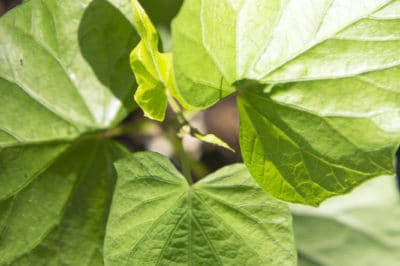About Sweet Potatoes
Sweet potato – Ipomea batatas – is a tropical perennial vine, probably native to India. Standard sweet potatoes may grow up to 16 feet long and produce large tubers in colors such as orange, red and purple. The plant also comes in bush and semi-bush forms, as well as ornamental varieties, many with colorful leaves. It grows best in USDA Zones 8 through 11.
Starting Sweet Potato Vines
Start with an organic sweet potato from your garden or the store (regular sweet potatoes may be treated with sprout inhibitors). Find a glass container slightly larger in diameter than the tuber. Insert toothpicks around the circumference of the potato and let it rest on the jar rim. Fill with water to cover about three inches of the tuber and place in a sunny windowsill.
Growing Sweet Potato Vines
In addition to harvesting leaves from the sweet potatoes growing in your garden you can grow them in containers. Choose one about 3 feet square to provide enough room for the roots. You can also continue to grow them in water. This is a great way to supply nutritious fresh greens all winter as well as have one or more houseplants.
Storing Sweet Potato Leaves
Think of sweet potato leaves as you would any leafy green. You can store them as follows:
- Washed and wrapped in a damp paper towel inside a plastic bag with ventilation holes.
- Frozen – blanch, shock in ice water and pack in zip-lock bags.
- Store on the vine and harvest as necessary.
Using Sweet Potato Vine
While the stems are edible, they are often tough. Harvest leaves with a sharp knife. Rinse and cook in boiling water until wilted; serve with butter, oil or dressing. You can also chop them and stir fry with oil, garlic, salt and pepper or add to soups and stews. To use them raw, roll the leaf and slice very thin perpendicular to the roll. The sliced leaves can be added to salads.
Nutritional Analysis
Research on the nutrients in sweet potato vines is limited. However, the leaves are a good source of ascorbic acid, or Vitamin C. Young leaves contain the highest amounts. The reverse is true of riboflavin – one of the B vitamins – mature leaves are higher than young leaves. Vitamin B6 is another valuable nutrient found in sweet potato leaves. Again, the mature leaves contain more than younger leaves.
